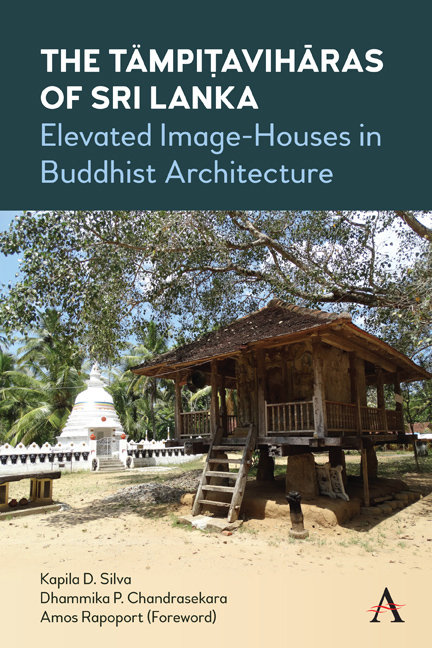North Western (Vayamba) Province
Published online by Cambridge University Press: 16 December 2021
Summary
Baladora Ṭӓmpiṭavihāra, Kuruṇǟgala District
Located in the Pahaḷa Baladora village, this ṭämpiṭavihāra could be reached via Pahaḷa Baladora road 2.3 km east from Halmillakoṭuva junction, which is 4 km north on Kaḍawalagedara-Witikuliya road from Nugawela junction on Puttalama-Vāriyapola road. The Baladora village consists of two communities – Pahaḷa (lower) Baldora and Ihala (upper) Baladora. According to folklore, the temple was established specifically for the community of Pahaḷa Baladora as they did not want to depend on the temple of the upper village for religious worship. The ṭämpiṭavihāra is built as a twostorey structure on relatively tall stone pillars to create a usable ground-level floor. The cella-cum-ambulatory is placed on the upper floor, accessed via a wooden stairway set on the left side of the structure. Both the cella and the ambulatory are fully enclosed with walls, and five small windows bring light into the ambulatory. The beam framework that holds the upper floor is extended over the stone pillars to support a lowerlevel roof eave that runs on all sides of the structure. This lower eave highlights the distinct two-storey appearance of the ṭämpiṭavihāra. There are seven images in the ätulgäba, two of which depict Kīrti Śrī Rājasiṅghe and Väliviṭa Saraṇṃkara Thērō, indicating that the ṭämpiṭavihāra was likely built in the mideighteenth century. Scholars believe that the stone pillars were brought from the ruins of the historic citadel of Paňḍuvasnuvara, just 3 km west of Nugawela junction. The image-house was renovated in 1995 by the Archaeological Department of Sri Lanka.
Bihalpola Ṭӓmpiṭavihāra, Kuruṇǟgala District
Placed atop a rock outcrop that rises about 100 m above the plain, the ṭämpiṭavihāra has a commanding panoramic view of the surrounding paddy fields, coconut groves, hillocks, and hamlets. It is located 100 m off Kuliyāpiṭiya-Nārammala road, 9 km west of Nārammala town. The tämpitavihāra is a part of an ensemble of buildings that include a dhātu mandiraya (relic-house) and two plinth-style image-houses. While the temple dates to the Kuruṇǟgala period, this group of buildings belongs to the Kandyan period.
- Type
- Chapter
- Information
- The Tämpitaviharas of Sri LankaElevated Image-Houses in Buddhist Architecture, pp. 97 - 126Publisher: Anthem PressPrint publication year: 2021

